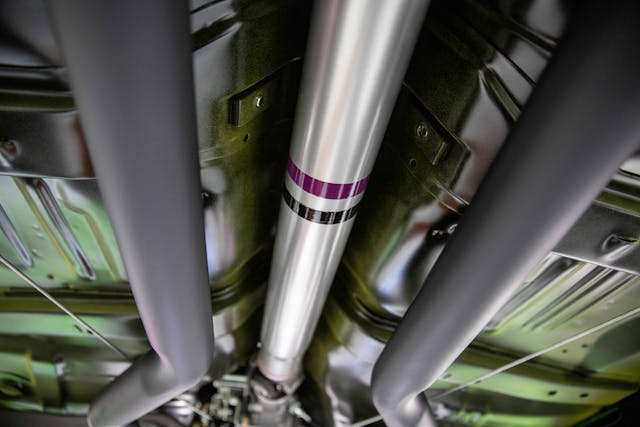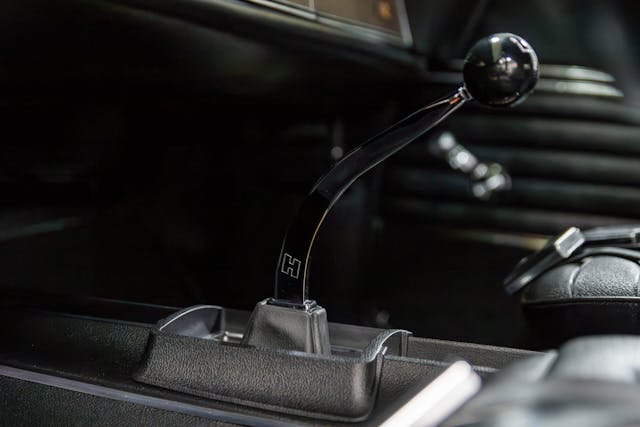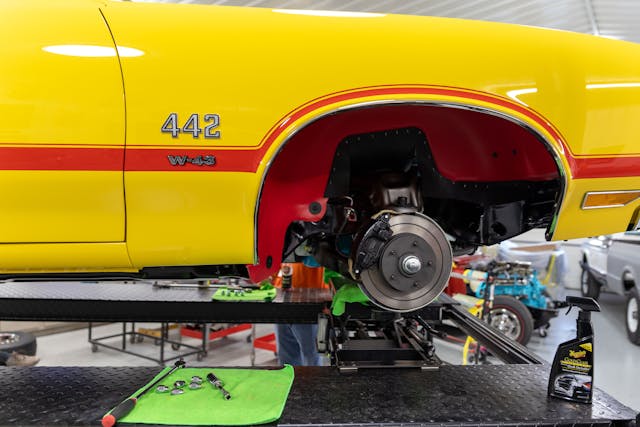How Detroit-Area Twin Brothers Revived a “W-43” Olds V-8 Prototype for Autorama
Twin brothers James and John Kryta, 54, and of Romeo, Michigan, are professional car enthusiasts. They own over 40 collector cars, and their livelihood is derived from a popular restoration support business. Their extracurricular activity of choice, oftentimes, is to invest endless hours polishing their rides for the show circuit. Their latest concoction, for the 2024 Detroit Autorama is a prototype 32-valve Oldsmobile V-8 engine that they rebuilt with extremely rare vintage parts and dropped into a yellow 1970 4-4-2. Oldsmobile called this engine the W-43, but the Kryta brothers call it “The Killer.”
Even though they’re identical twins, according to James they do have a few differences. “Yes, we shared a womb and a room. But during our teen years, when we both became hands-on car enthusiasts, our father wisely informed us we’d never earn much of a living with grease under our fingernails. So, I obtained an aircraft powertrain mechanic’s degree at the Pittsburgh Institute of Aeronautics, and John studied architecture and engineering at the University of Detroit.



“My father’s advice was dead nuts. When I was 16, I bought my first car, a ‘71 Olds 4-4-2 W-30, for $2200. A few years later, my second car purchased after I had begun working cost more than ten times that amount.”
Following graduation, James was employed by aviation services company DynAir at various U.S. locations. “One day, while inspecting an extensively damaged aircraft wing,” he recalls, “I noticed it was packed full of fluid lines. When my boss offered me the chance to learn how to fabricate those lines, I wasted no time saying ‘Yes, sir!’”
The knowledge he subsequently gained moved James to create the restoration business Inline Tube in 1995. Brother John joined the enterprise a year later. What began in a two-car garage grew into four buildings staffed with 50 employees shipping a thousand packages per day. Inline Tube currently offers the restoration hobby’s finest brake and fuel lines, hoses, cables, fittings, fasteners, and attachment clips galore.





Much of the sparkle that Detroit Autoama attendees witness is attributable to Inline Tube’s products and the cars the Kryta brothers frequently enter. It’s not unusual to see John’s Pontiac GTO competing against James’ Oldsmobile in the hard-fought Restored class. This year, the year of The Killer, is an exception.
With John’s current project in the paint shop, it was James’ job to bring home this year’s bacon. His Olds had a humble beginning: It was parked outside for years in Indiana, the engine was gone, and it took five years to refurbish. That said, its most remarkable attribute is what now lies beneath the twin-scooped hood.
“Twenty years ago, while shopping RacingJunk.com,” John explains, “I stumbled across a listing for some prototype Oldsmobile engine equipment. While I’d never heard of the 455-cubic-inch, 32-valve W-43 V-8, I was intrigued to say the least. The asking price for this gear was $10,000; naysayers called it a boat anchor and insisted it would never run. Nonetheless, we grabbed that prize for $5000 and what we dubbed ‘The Killer V-8′ will be showcased in James’ 1970 Olds 4-4-2 coupe at this year’s Detroit Autorama.”

The plot thickens. “In the early 1970s,” John says, “shortly after the W-43 lost all hope of entering production, several Olds engineers and PR personnel flew out to California to tout their project for Petersen Publishing Company editors at Car Craft, Hot Rod, and Motor Trend magazines. At that time, this wasn’t a complete running engine but rather a hollow shell suitable for photography and a collection of internal parts highlighting the W-43’s attributes.” (Read our technical breakdown of the Oldsmobile W-43 V-8 here.)
“The trip to California was to gain publicity, after the engineering project had been terminated by GM’s upper management. Given that, the Olds folks asked the writers to chuck these engine parts in a dumpster after their stories were completed. Lucky for us, that request was ignored. These priceless W-43 components went home with someone from Petersen in 1971, only to resurface decades later.



“Cajoling the vintage parts into a running engine was no small feat. The first problem was a parts shortage. One cylinder head was missing, so we had to reverse engineer it and a few other components. Extensive machining was required. All told, 20 people got involved, including one ex-Oldsmobile engineer who requested anonymity. Scott Tiemann, the CEO of Supercar Specialties in Portland, Michigan, quite capably handled final assembly.”

So, what kind of power does this 32-valve V-8 produce? “We were prudent during testing to avoid blowing up our irreplaceable parts. Imposing a modest redline, we measured 560 hp at 6000 rpm and 540 lb-ft of torque at 3600 rpm,” James Kryta notes. “But eliminating the significant restrictions by adding multiple carbs and efficient exhaust headers would easily have improved those figures.”

To inspect the W-43 engine and James’ yellow 1970 4-4-2, we visited a clandestine detailing shop located 50 miles north of GM’s long-gone Lansing assembly plant where this Olds was built. The facility’s proud owner began the tour with an inspection of the car’s sparkling underside. At the rear, there’s an interesting final drive consisting of an aluminum W-27 center section creatively welded to steel axle housings. The driveshaft has twin paint stripes replicating marks that would have been applied by the factory during its spin-balancing operation. Like W-30 4-4-2s of the day, the transmission is a Muncie aluminum-cased four-speed stick. I was amazed at how many undercar parts left the factory without a hint of paint or rust protection, but James insisted this was standard practice back in the day.




This 4-4-2’s scooped hood combines a fiberglass outer element married to a stamped-steel liner ramming cold air to a 750-cfm Rochester Quadrajet. The broad silver-and-blue valve covers pierced by spark plugs will surely attract drooling admirers at Autorama, along with the bright red fender liners. The W-43 emissions sticker, created by James, is another fastidious touch. When asked how or from where he found a perfect vintage battery, he reported, “I made those filler plugs with my 3D printer. In addition, I attend lots of shows to buy up new-old-stock parts for our cars.”
My hour-long inspection revealed that this factory experimental Olds 4-4-2 W-43 is perfect down to the tiniest detail. I will be on hand at Detroit’s Huntington Place, formerly Cobo Hall, to applaud what I suspect will be its victory.





***
Check out the Hagerty Media homepage so you don’t miss a single story, or better yet, bookmark it. To get our best stories delivered right to your inbox, subscribe to our newsletters.



Thanks for your commitment to this icon of American Muscle.
Great story.
What a cool engine. Imagine if this had made production. The numbers are great, I want to hear what it sounds like. The blue is a very nice touch on this engine.
I’m sure it’s the only one in the entire universe. It is super-cool & I’ve read about that engine several years ago, and I’d also love to hear it run! It’s definitely a beauty! 426 has NOTHING on it!
The only way i have heard of to weld steal to aluminum is friction welding. I doubt that happened here. You would also have some corrosion issues. But perhaps you can enlighten me?
GM did that from the factory, they figured it out. Those W-27’s fetch well north of $10k, realistically, probably $20k these days if you can even find one.
I would sacrifice a part of my left side anatomy for that engine! Heck, might as well go for the whole car. James does a fabulous job on his cars, and I’ve bought several items for my W-30 from his business. I’d love to go check this car out in person!
Water jackets do not appear to line up… Amongst other things…
It’s a shame you weren’t in charge of this build. Then, I’m sure, everything would’ve been perfect — and the build would’ve taken far less time, and cost far less money.
I saw one of these engines in the REO museum in the early to mid 80s. Is it still there?
My dad had a Olds 442 Cutlass, but it was replaced by a long string of Pontiac Trans Am’s after owing it for a short time. Never told me why he sold it. This car is beyond stunning, imagine what GM could have done with a twin cam back then.
I have the W-27 aluminum rear under my 1970 F85 W31 post car . I have owned her for 51 years. Completely numbers matching car ! It still rocks my world!
Gene, I couldn’t be more jealous ! Congrats ! I only have a ’68 442 sports coupe, but it’s loved.
We had a chance to look it over briefly yesterday at Autorama. The color on this car is great. I walked around and saw the W-43 badge and thought “W-43? Never heard of it”. Nice to read the whole story here.
I was fortunate enough to be at Supercar Specialties shop this past summer, Scott was showing me what he was currently working on including this prototype engine, I have to give Scott and the Kryta brothers a lot of credit for completing this engine and the car in time so that I was able to see the finished product at Detroit Autorama. When I saw the engine in this past summer, it was a long ways away from being ready for Detroit Autorama, hats off to you guys, I know you have been friends for a long time, looks like it was a great team effort, Thumbs Up!
Well leave it to Olds to lead the pack…and boy did they lead the pack in the dust with the W43. I don’t believe Mopars 426 Hemi would of been the most sought out engine if the W43 had gone into production. My father was a Olds fanatic while I was growing up. He had a transmission shop in South central L.A. in the 60s and bought a brand new 62 Starfire Black/Blue off the showroom floor at J.W. Taylor Olds dealer in South Gate, CA. That 394 4bbl carb was already a monster but a week after he bought the car he pulled the engine and installed 12 to 1 Jahns Racing Pistons and had the heads reworked….ported n relieved. Now the monster was wide awake on steroids lol. There were very few cars that could keep up.ot beat it! Lol